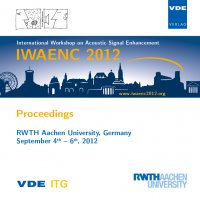Discriminability Measure for Microphone Array Source Localization
Konferenz: IWAENC 2012 - International Workshop on Acoustic Signal Enhancement
04.09.2012-06.09.2012 in Aachen, Germany
Tagungsband: IWAENC 2012
Seiten: 4Sprache: EnglischTyp: PDF
Persönliche VDE-Mitglieder erhalten auf diesen Artikel 10% Rabatt
Autoren:
Nunes, L. O.; Martins, W. A.; Lima, M. V. S.; Biscainho, L. W. P. (Federal University of Rio de Janeiro, DEL/Poli & PEE/COPPE, Rio de Janeiro, Brazil)
Lee, B.; Said, A.; Schafer, R. W. (Mobile & Immersive Experience Lab, Hewlett-Packard Laboratories, Palo Alto, CA, USA)
Inhalt:
The performance of sound source localization systems based on microphone arrays is dictated by a combination of factors that range from array, source, and environmental characteristics to the nature of the localization algorithm itself. Array geometry is an example of critical feature for source localizability. This paper proposes a numerical measure of the capability of a microphone array with a specific geometry to distinguish a given point in space from its neighbors. Such numerical measure, herein called discriminability index (D), has the interesting feature of taking into account only the effects of array geometry on spatial resolution, thus providing a way of connecting a microphone array geometry to the region of interest. The proposed measure can be particularly useful to help choose an appropriate array geometry when a sound source is confined to a predefined region. Simulation results using the classic SRP-PHAT method are presented for highlighting the correlation between D and the accuracy of the source location estimates. Index Terms — acoustic signal processing, microphone arrays, sound source localization


